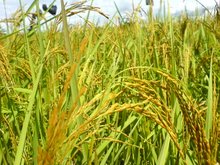Not long after, came a young lady asking whether we care to join her for a short factory tour? When she saw our long dismissal face...she quickly explained that there will be no entrance fee. Hehehhe..so, dah sampai sini..takan tak nak singgah betul tak? So..what the heck...lagipun free.

As you all know, Holland is unquestionable the `cheese country' not only because of its high export or the wide variety of Dutch cheeses available at the supermarket or delicatessen but also because the Dutch culture is entrenched in cheese. Cheese primarily consists of the solid elements of milk: the fat, the proteins and the vitamins and minerals. Ten kilos of milk are required to make one kilo of cheese.
The curd then pressed into moulds. After which the cheese goes into a brine bath for several days. The reasons for this process, salt (brine) gives the cheese its savoury taste and inhibits the growth of undesirable bacteria which can also affect the flavour. Whilst the cheese is maturing the long molecules break down. In addition, carbon dioxide is formed, which causes the `holes' in the cheeses which professionals call `eyes'. Some cheeses have extra large holes due to the addition of propionic acid which also gives the sweet, nutty flavour.


Cheese or 'kaas' in Dutch
Subsequently it is stored and thus gradually matures into the delicious product we can buy in the shops. Well, that's about it..short tutorial in making Cheese.
In addition, after serving, if you have any cheese left over, you'll want to re-wrap it and place in the cheese or vegetable compartment of your refrigerator. These drawers are designed to provide extra humidity, just the thing for keeping cheese at its peak.
Clogs. Traditional clogs were made out of willow or poplar wood. For the Dutch, clogs are known as klompen. The traditional, all wooden, Dutch clogs have been used as everyday shoe during 18th and early 19th centuries. During that period, most of the Dutch were living in inadequate condition and generally they can't afford leather shoes.
So, instead of wearing a leather shoe, they wore a wooden shoe that made from willow tree or Poplar Tree which they can be acquire easily.
Also, Dutch people mainly were farmer, the use of wooden shoe also apply as a safety shoe to provide them from cow or horse stumping to their feet. Early version of OSHA in the 18th centuries. Plus, they were heavy duty too. From what I've learned form the clogs lady, a pair of clogs can withstand as long as 3 years in the hardest circumstances.
Today, Dutch clogs are available in many tourist shops. Wearing clogs is considered to be healthy for the feet.

Start with a block of wood
Below is a picture of one of traditional tool in clogs making. A very good clogs maker can produce as much as 3 pairs in a day. The tools below is where you shape a block of wood into clogs shape.
Well, guys that's pretty much about it.
p/s:Although there is no entrance fee, she sure knows how to take Euro21.50 out from me for a pair of clogs and a smoke brown cheese.















2 comments:
how's the taste of such cheese? did u get a tryout on making those clogs?
nice post love reading it.
Post a Comment